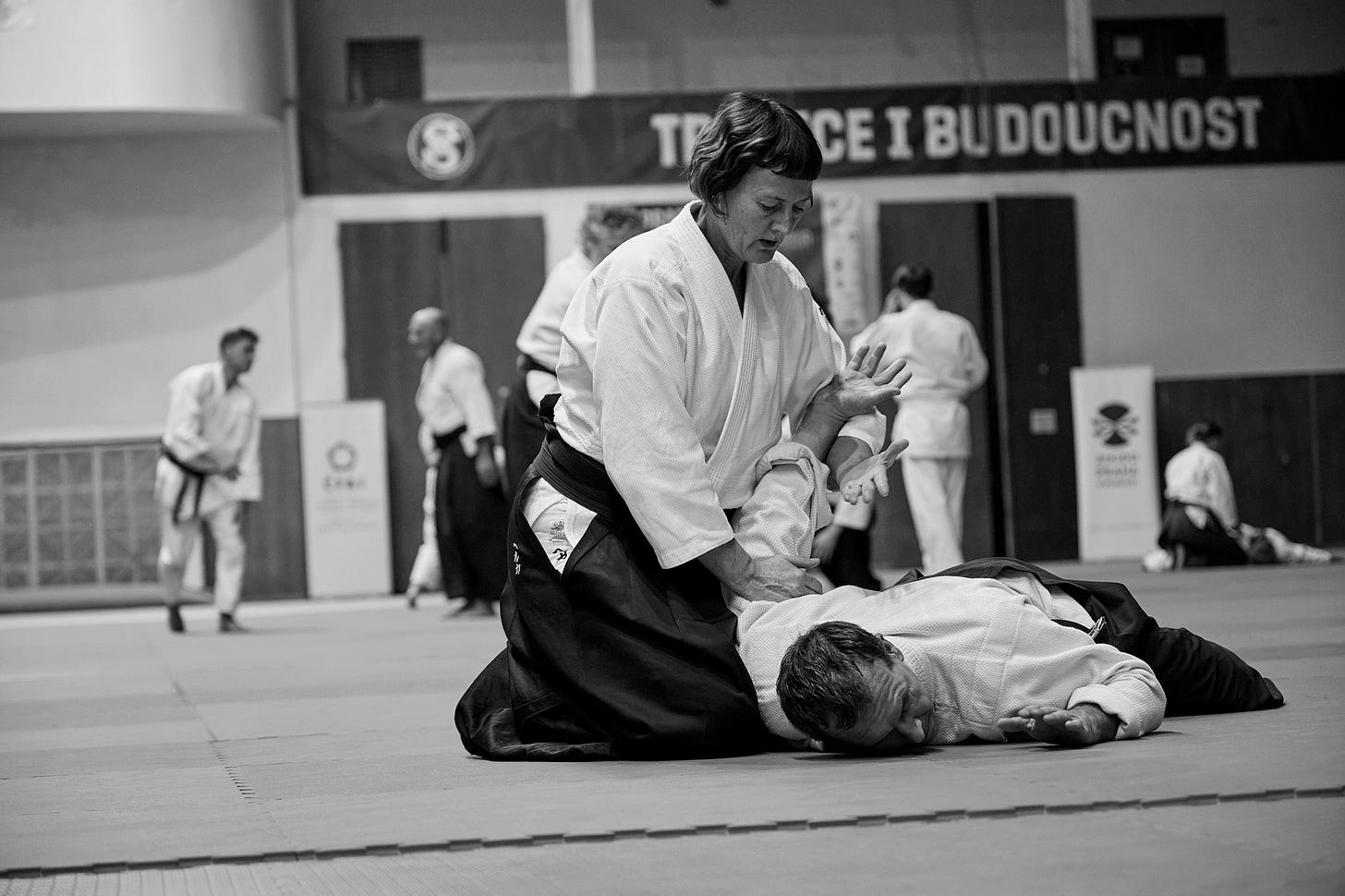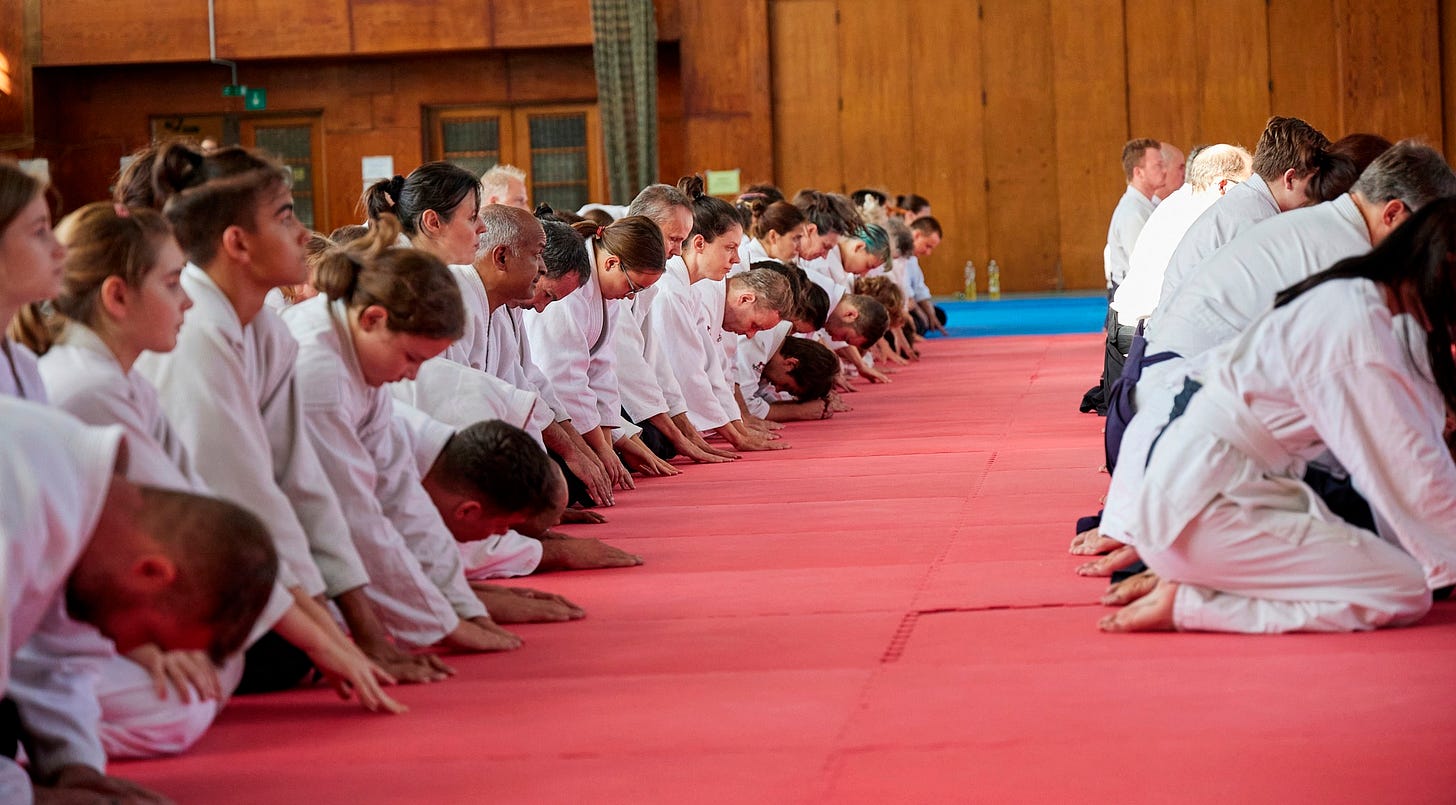Aikido as Misogi / Purification
Building or Dissolving Defenses: Introducing the Two Contrasting Approaches to Aikido Practice
The founder of Aikido reportedly said that “Aikido is misogi”1—a kind of purification, or cleansing of body and mind. From the perspective of his spiritual practice, that makes sense—he was deeply immersed in the Shinto religion of Japan.
But for his students—and for us—that message can feel unclear. Shinto places a strong emphasis on purification, so even everyday activities can carry a cleansing dimension. The idea is that the purer we are, the better universal energy can flow through us.
But what can we actually do in Aikido to “cleanse ourselves”? Other than showering after a class, of course?

Two Opposite Approaches to the Practice
In my view, there are two ways we can approach Aikido practice.
In the first, we train to build a safe fortress of technique, body, and mind—something to shield us from the dangers of the world. We gain experience, skills, and strength to control ourselves, others, and the situations around us. We gradually become more confident that our way is the right one, that we understand the essence of the art—and maybe even life itself.
With every class, we become more sure of ourselves and more fixed in our view. We tend to train with partners who practice like us, and they reinforce that certainty.
This approach is natural and instinctive. We all need physical safety, a sense of belonging, and the comfort of believing we understand the world well enough to control it.
The second way is the opposite. We train to release unnecessary tension—both in our muscles and in our minds. We explore various forms to awaken different parts of our body. We try to move with precision in one way, only to shift and be precise in another. Eventually, we realize we can always move precisely—and that there are infinite ways to do so.
We meet different people, hear different stories, and glimpse new perspectives. The movement, the technique, the relationship with our partner—all of it opens us up. We become more integrated and more relaxed. It’s as if, with each training, we’re slowly washing away old injuries, forgotten traumas, and ideas we no longer need to hold on to.
This second approach takes courage. It asks us to face our inner fears—and work with them.
So, Aikido can be used to build up our defenses against the world or dissolve those defenses.
Of course, in reality, both things can happen at the same time. We learn new techniques and principles that help us let go of old views of the world. We strengthen some muscles so others can relax. We need a clear image of the movement so we can eventually do it effortlessly.
Beginners especially need to gather techniques, strength, and a sense of safety—many of them come to the dojo hoping to defend themselves, build up their body, set boundaries, or find a like-minded group. Aikido can offer all of that.
But the more advanced we become, the more we can remind ourselves of this perspective of purification.
How Can We Do It in Practice?
From my perspective, misogi happens in three areas: the body, the relationship with the partner, and the mind.
Purifying the Body
Through practice, we can release tension, reduce stress, or recover from old injuries. Every technique can reawaken the body and offer feedback on how it functions—and what could be improved.
At my teacher’s summer school, we practiced a very straightforward iriminage. No turning—just a slight change of angle, with the entrance completing the movement. On my left side, it went great. But on the right, I couldn’t find the right place to step to make it work. I tried it again and again, getting frustrated.
Then I compared the left and right sides and noticed something interesting: my right foot couldn’t step where it needed to, because my right hip couldn’t internally rotate enough—it always stepped away from the partner instead of toward him. A strange movement pattern, maybe from an old injury. I’d never noticed it before.
Thanks to that discovery—and more training—I gradually improved that mobility. Now I can do that short iriminage on both sides, and my hips are more mobile.
In the same way, practice can also reshape the body of uke—the attacker who takes the fall. A hold or pin can help circulate blood in the joints and release tight tendons. Being thrown or unbalanced wakes up the body from all angles.

If the technical repertoire is diverse enough, and if we pay attention to excess or lack of tension, the body begins to harmonize and balance itself. Posture becomes more natural, and movement freer.
Simplifying the Relationship with the Partner
Aikido is practiced in pairs, so our partner helps us notice the emotions that arise while we train. Some people are a joy to train with. Others, well… they get under our skin. Have you felt that too?
I was practicing with Z. at a seminar and he’s one of a few people I didn’t like practicing with. We both did the technique more or less correctly, but something about his behavior bothered me. I watched my own discomfort and tried to understand it.
Of course, I could have just thought, “He’s an idiot, not worth training with,” and pushed it out of my mind. But I asked myself: “Whatever he is like, can I train with him in a way that doesn’t bother me?” 2
I noticed that his face would tense up every time something didn’t go well, and he’d immediately try to fix it. Interesting. I’m a bit like that too—I sometimes try too hard to look good in front of others. Was that what was bothering me? Was I competing with him to see who’s Aikido is “better”?
The next time I saw Z., a year later, I trained with him much more comfortably. He hadn’t changed—but I had. I had released something I was carrying into the training. A small, unnecessary emotion.
The relationship with our partner isn’t about proving who’s right. It’s a mirror where we can see ourselves. That’s how Aikido training can help us become more open toward others—not just on the tatami.
Emptying the Mind
Just like our body can hold onto tension, so can our mind hold its assumptions, expectations, and conditioned patterns.
When I was a beginner in Aikido, our training was very simple. This is ikkyō, this is iriminage, this is kotegaeshi. Each technique had exactly one version, because our teachers were beginners too.
Then I started going to seminars. And things got confusing. It took my mind a while to accept that each technique had countless variations—that ikkyō could look many different ways.
Later, when I began traveling abroad, I had another surprise: in different places, people trained with completely different styles. They often didn’t do what I expected them to. That was incredibly frustrating because I insisted my techniques should work the way I learned them.
It took a few more years, but eventually, my mind became more flexible, more in tune with what I was actually experiencing with my partner. Something interesting happened: when I stopped clinging to my idea of the technique and started responding to the real situation, my technique became clearer and more precise.
Maybe this is the kind of “cleansing” that leads to mushin—the empty mind often talked about in Japanese martial arts.
Letting Go and Moving On
In general, if we come across any kind of tension—in our body, in our relationship to others, or in our thoughts—it doesn’t help to stop training, feel bad about it, or blame someone else. The best thing is simply to notice it and keep practicing.
With this kind of neutral attention, the tension gradually dissolves. We forget it was ever there.
That, for me, is misogi.
This applies to both long-term and short-term goals too. Goals are a form of focused attention—a useful kind of tension that pulls us forward for a while.
Most of us have this experience: we started Aikido with one reason, but later that motivation faded, and a new one appeared. Then even that one fell away, and something else emerged. We explore something through Aikido—and then let it go.
We learn to roll forward, pass a grading, lose weight, strengthen our body, get a black belt, take a photo with a Japanese teacher... We can build our identity around it for life, or we can smile and move on.
Aikido becomes an art where we gradually forget the goals we once set. That too, for me, is misogi.
And maybe, through Aikido and its techniques, we’ll explore that deeper fear—the fear that someone out there might hurt us. Step by step, we open, release, and realize: there’s nothing to be afraid of.
For example in the Interview with Seiseki Abe
This kind of open approach does have its limits. If someone on the tatami tries to hurt you—physically or emotionally—you absolutely have the right to protect your boundaries and refuse to train with them. Your health and integrity should always come first.
Related Articles
Read more articles from the cycle Aikido As …





Wow! That’s brilliant and I’m saving the article for future reference.